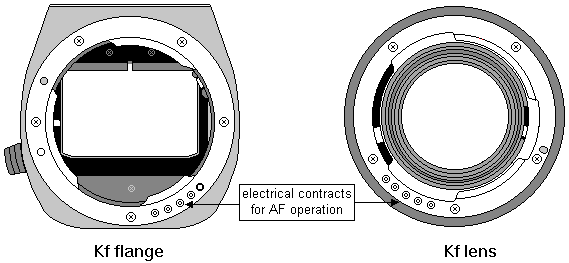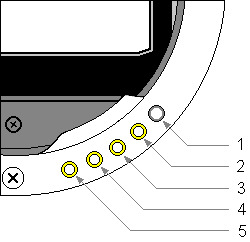Features and Operation of the KF Mount
- Lenses:
- SMC Pentax-AF 35-70/2.8
- Bodies:
- ME F
- Compatibility Issues:
- The ME F is unusable with the FAJ lenses, and the AF 35-70/2.8 is virtually unusable with bodies featuring the “crippled” KAF mount. All other possible combinations produce manual-focus cameras with full-frame and center-weighted metering and capable of M or Av operation. Combining the ME F specifically with the AF 35-70/2.8 lens adds primitive AF capability to the list of features.
Overview
In 1981 Pentax brought to the market the world’s first auto-focus (AF) camera equipment: the ME F body and the SMC Pentax-AF 35-70/2.8 lens. Both feature the KF mount — an AF-capable extension of the original K mount. Unfortunately, the lens is too large and heavy, the AF too slow, the concept not very flexible, and the whole idea was not promoted aggressively enough by Pentax. As a result, no further KF mount equipment was produced, the AF pursuit was soon abandoned, and Pentax continued producing equipment based on the original K-mount.
With the KF mount equipment, the AF motor and the four AAA batteries that power it are located inside the lens. The AF sensor and the control electronics are located in the camera body. The AF functionality of the KF mount is incompatible with the modern Pentax AF mounts, so the ME F and the SMC Pentax-AF 35-70/2.8 provide AF-functionality only when coupled together. In all other combinations, the AF lens behaves as an automatic-aperture original-K mount zoom, and the ME F as an M-series body with the additional benefit of AF assist.
“AF assist” refers to three LEDs visible in the camera’s viewfinder. The middle one, the “AF confirm”, is a green hexagon and lights up when the camera “thinks” that the lens is properly focused. The two LEDs on the left and right are red and shaped like arrows. When lit up, each one indicates the direction in which the focusing ring should be turned in order to achieve proper focus.
Operation
The KF mount has all features of the automatic-diaphragm original K mount, plus the following additions.

Figure 1. Diagram of the KF mount.
George de Fockert has partly reverse engineered the KF mount, and has found the electrical contacts to have the following functionality:

Figure 2. Detail from the KF body mount.
- When the lens is turned on and one of the lens focus buttons is pressed, this slightly recessed camera contact triggers the camera’s light meter and focus detector. This has the same effect as slightly depressing the camera’s release button. Shorting the camera contact to the bayonet metal turns the camera light meter and focus detector on.
- Not connected inside the lens, and therefore probably unused.
- Applying a small voltage i makes the lens focus towards infinity.
- Applying a small voltage i makes the lens focus away from infinity.
- Not connected inside the lens, and therefore probably unused.
i = As generated by a multi-meter in “resistor mode.